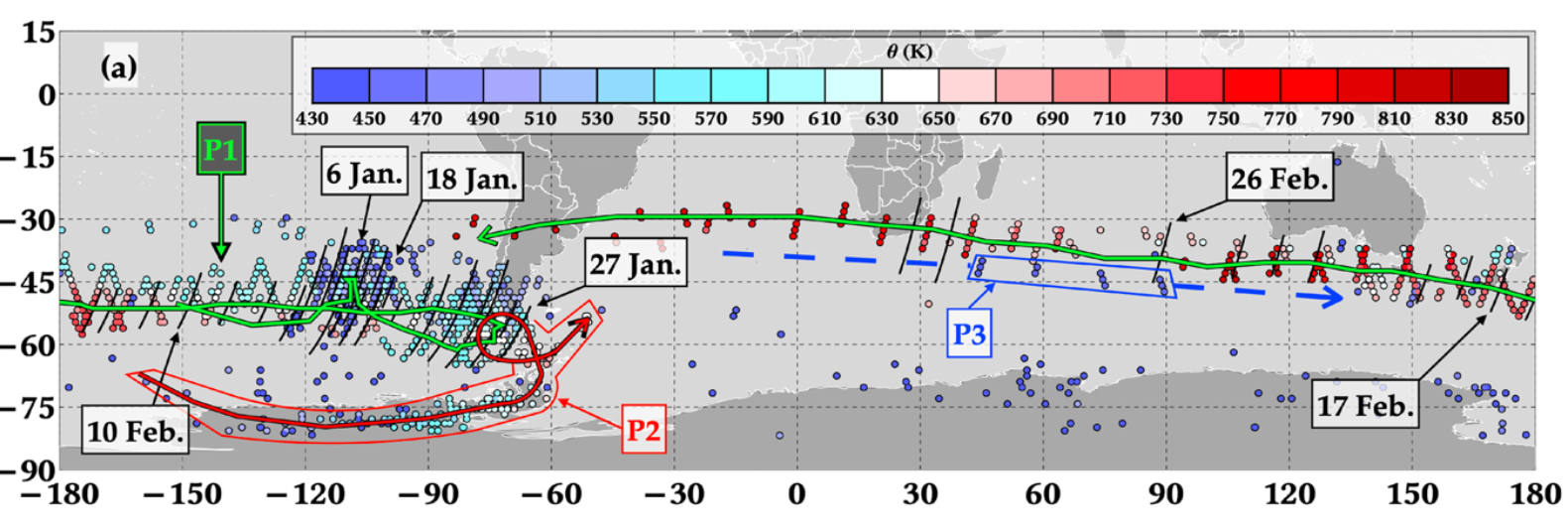The plume maintained record-high abundances of Microwave Limb Sounder (MLS) H2O and CO as it rose into the middle stratosphere. Multiple plumes can be tracked in MLS trace gases, with the densest plume remaining coherent for more than two months. Solar heating of soot not only lofted the plume, but also produced a ~1000 km wide anticyclonic vortex, the first such dynamical response reported to a pyroCb smoke plume. The slow rate of mixing of the plume with its environment may be due to its strong rotation. A dipole structure observed in MLS temperature is associated with the anticyclone, with anomalous warming above the plume and cooling below the plume of magnitude as large as ±9K. Low anomalies in MLS O3, a stratospheric tracer, and high anomalies in N2O, a tropospheric tracer, are signatures of the intrusion of tropospheric air into the stratosphere.
Soot, water vapor, and combustion products injected by the Australian pyroCbs had a significant impact on lower and middle stratospheric composition. Rising, rotating plumes allow combustion products to penetrate well into the middle stratosphere, with possible implications for the ozone layer. Such events are likely to become more common with climate change.

(a) The pyroCb plume is tracked using outliers of MLS H2O and CO.

(b) Multiple plumes can be traced by following these anomalies.

Anomalous values of (c) MLS O3 and (d) MLS N2O are colocated with (e) H2O anomalies.
Technical Description of Figure:
(a) Plume profiles are identified using thresholds of MLS H2O > 7 ppmv and MLS CO > 50 ppbv in the lower stratosphere. MLS H2O maintains record-high values exceeding 15 ppmv for more than two months. (b) Multiple plumes can be traced by following these anomalies. "P1" has the highest mixing-ratio anomalies, the fastest ascent, the strongest rotation and is the most persistent of the plumes, but "P2" also shows some rotation. Anomalous values of (c) MLS O3 and (d) MLS N2O are colocated with (e) H2O anomalies.
Scientific significance, societal relevance, and relationships to future missions:
This work demonstrates that pyroCb injections can have significant, hemisphere-wide impacts on the lower and middle stratosphere that can persist for months. The observed dynamical responses to the heating of smoke in the plume by absorbed solar radiation shows how pyroCb plumes can penetrate deeply into the stratosphere, lessening the possibility that anomalies are locally confined and/or quickly flushed back into the troposphere. PyroCb injections are expected to increase in frequency and intensity with climate change. No concrete plans for future height-resolved satellite measurements of lower stratospheric CO (by NASA or other agencies) currently exist. The Belgian Altius mission will measure stratospheric water vapor, but only in a sparse "solar occultation" geometry. The Swedish SIW mission will make daily near global stratospheric water vapor measurements, but they will not extend into the upper troposphere.
Data Sources:
References: Kablick, G. P. III, Allen, D. R., Fromm, M. D., & Nedoluha, G. E. (2020). Australian pyroCb smoke generates synoptic‐scale stratospheric anticyclones. Geophysical Research Letters, 47, e2020GL088101. at https://doi.org/10.1029/2020GL088101
11.2020